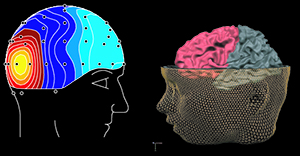Welcome!
 The Hopfinger Lab, in the Department of Psychology and Neuroscience, investigates attention, distraction, and selective perception. We use multiple methods to elucidate the neural mechanisms of attentional control. These methods include measures with high spatial resolution, such as functional magnetic resonance imaging (fMRI), to pinpoint neural regions and networks, and measures with high temporal resolution, such as EEG and Event-related potentials (ERPs) to follow the ultra-fast dynamics of brain activities underlying these complex processes. We are also using methods of neurostimulation, such as transcranial alternating current stimulation (tACS), to test theories of brain function and plasticity through direct biasing of brain activity.
The Hopfinger Lab, in the Department of Psychology and Neuroscience, investigates attention, distraction, and selective perception. We use multiple methods to elucidate the neural mechanisms of attentional control. These methods include measures with high spatial resolution, such as functional magnetic resonance imaging (fMRI), to pinpoint neural regions and networks, and measures with high temporal resolution, such as EEG and Event-related potentials (ERPs) to follow the ultra-fast dynamics of brain activities underlying these complex processes. We are also using methods of neurostimulation, such as transcranial alternating current stimulation (tACS), to test theories of brain function and plasticity through direct biasing of brain activity.
Our lab is committed to promoting diversity and considers an ideal scientific community to be one that includes a diverse representation of individuals at all academic levels. We are committed to training students and scientists of diverse backgrounds. We encourage students from backgrounds historically underrepresented to apply to our lab, including but not limited to BIPOC, LGBTQ+, and first-generation college students.
Please follow the links above to learn more about our lab. A new research highlight discusses some of Dr. Hopfinger’s recent research: read more online.
